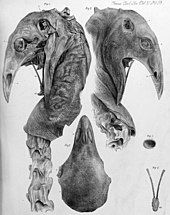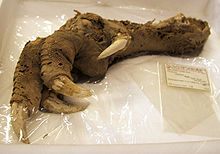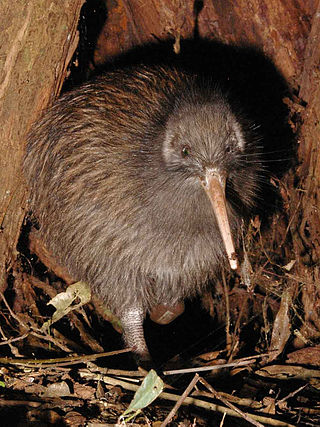
Kiwi are flightless birds endemic to New Zealand of the order Apterygiformes. The five extant species fall into the family Apterygidae and genus Apteryx. Approximately the size of a domestic chicken, kiwi are the smallest ratites.

Moa are an extinct group of flightless birds formerly endemic to New Zealand. During the Late Pleistocene-Holocene, there were nine species. The two largest species, Dinornis robustus and Dinornis novaezelandiae, reached about 3.6 metres (12 ft) in height with neck outstretched, and weighed about 230 kilograms (510 lb) while the smallest, the bush moa, was around the size of a turkey. Estimates of the moa population when Polynesians settled New Zealand circa 1300 vary between 58,000 and approximately 2.5 million.
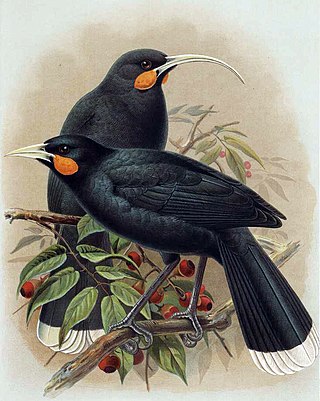
The huia is an extinct species of New Zealand wattlebird, endemic to the North Island of New Zealand. The last confirmed sighting of a huia was in 1907, although there was another credible sighting in 1924.

The adzebills, genus Aptornis, were two closely related bird species, the North Island adzebill,, and the South Island adzebill,, of the extinct family Aptornithidae. The family was endemic to New Zealand. A tentative fossil species,, is known from the Miocene Saint Bathans fauna.

The bush moa, little bush moa, or lesser moa is an extinct species of moa from the family Emeidae.

The giant moa (Dinornis) is an extinct genus of birds belonging to the moa family. As with other moa, it was a member of the order Dinornithiformes. It was endemic to New Zealand. Two species of Dinornis are considered valid, the North Island giant moa and the South Island giant moa. In addition, two further species have been suggested based on distinct DNA lineages.

The eastern moa is an extinct species of moa that was endemic to New Zealand.

Pachyornis is an extinct genus of ratites from New Zealand which belonged to the moa family. Like all ratites it was a member of the order Struthioniformes. The Struthioniformes are flightless birds with a sternum without a keel. They also have a distinctive palate. This genus contains three species, and are part of the Anomalopteryginae or lesser moa subfamily. Pachyornis moa were the stoutest and most heavy-legged genus of the family, the most notable species being Pachyornis elephantopus - the heavy-footed moa. They were generally similar to the eastern moa or the broad-billed moa of the genus Euryapteryx, but differed in having a pointed bill and being more heavyset in general. At least one species is assumed to have had a crest of long feathers on its head. The species became rapidly extinct following human colonization of New Zealand, with the possible exception of P. australis, which may have already been extinct by then - although the most recent moa skeleton ever described is a partial skeleton of this species, radiocarbon dated to between 1396 and 1442.
The long-billed wren is an extinct species of New Zealand wren formerly endemic to the South Island of New Zealand. It was the only species in the genus Dendroscansor. It shares the name "long-billed wren" with the Brazilian bird Cantorchilus longirostris.

The New Zealand bittern is an extinct and enigmatic species of heron in the family Ardeidae. It was endemic to New Zealand and was last recorded alive in the 1890s.
Trevor Henry Worthy is an Australia-based paleozoologist from New Zealand, known for his research on moa and other extinct vertebrates.

The crested moa is an extinct species of moa. It is one of the 9 known species of moa to have existed.

The heavy-footed moa is a species of moa from the lesser moa family. The heavy-footed moa was widespread only in the South Island of New Zealand, and its habitat was the lowlands. The moa were ratites, flightless birds with a sternum without a keel. They also have a distinctive palate. The origin of these birds is becoming clearer as it is now believed that early ancestors of these birds were able to fly and flew to the southern areas in which they have been found.

The North Island giant moa is an extinct moa in the genus Dinornis, known in Māori as kuranui. Even though it might have walked with a lowered posture, standing upright, it would have been the tallest bird ever to exist, with a height estimated up to 3.6 metres (12 ft).
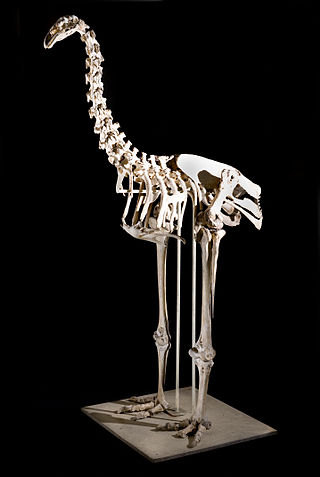
The South Island giant moa is an extinct species of moa in the genus Dinornis, known in Māori by the name moa nunui. It was one of the tallest-known bird species to walk the Earth, exceeded in weight only by the heavier but shorter elephant bird of Madagascar.
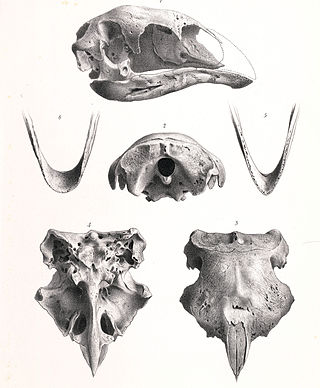
The broad-billed moa, stout-legged moa or coastal moa is an extinct species of moa that was endemic to New Zealand.

Mantell's moa also known as Mappin's moa is an extinct species of moa from the North Island of New Zealand. Its habitat was the lowlands. The moa were ratites, flightless birds with a sternum without a keel. They also have a distinctive palate. The origin of the ratites is becoming clearer as it is now believed that early ancestors of these birds were able to fly and flew to the southern areas that they have been found in.

The New Zealand goose is a bird of the extinct genus Cnemiornis of the family Anatidae, subfamily Anserinae. The genus, endemic to New Zealand, consisted of two species: the North Island goose, C. gracilis and the South Island goose C. calcitrans.



